实验课作业一
1. 实验任务1
#include <iostream> #include <string> #include <vector> #include <algorithm> using namespace std; // 声明 // 模板函数声明 template<typename T> void output(const T &c); // 普通函数声明 void test1(); void test2(); void test3(); int main() { cout << "测试1: \n"; test1(); cout << "\n测试2: \n"; test2(); cout << "\n测试3: \n"; test3(); } // 函数实现 // 输出容器对象c中的元素 template <typename T> void output(const T &c) { for(auto &i: c) cout << i << " "; cout << endl; } // 测试1 // 组合使用算法库、迭代器、string反转字符串 void test1() { string s0{"0123456789"}; cout << "s0 = " << s0 << endl; string s1{s0}; reverse(s1.begin(), s1.end()); // 反转指定迭代器区间的元素 cout << "s1 = " << s1 << endl; string s2{s0}; reverse_copy(s0.begin(), s0.end(), s2.begin()); // 将指定迭代区间的元素拷贝到指定迭代器开始的目标区间,并且在复制过程中反转次序 cout << "s2 = " << s2 << endl; } // 测试2 // 组合使用算法库、迭代器、vector反转动态数组对象vector内数据 void test2() { vector<int> v0{2, 0, 4, 9}; cout << "v0: "; output(v0); vector<int> v1{v0}; reverse(v1.begin(), v1.end()); cout << "v1: "; output(v1); vector<int> v2{v0}; reverse_copy(v0.begin(), v0.end(), v2.begin()); cout << "v2: "; output(v2); } // 测试3 // 组合使用算法库、迭代器、vector实现元素旋转移位 void test3() { vector<int> v0{0, 1, 2, 3, 4, 5, 6, 7, 8, 9}; cout << "v0: "; output(v0); vector<int> v1{v0}; rotate(v1.begin(), v1.begin()+1, v1.end()); // 旋转指定迭代器区间[v1.begin(), v1.end())之间的数据项,旋转后从迭代器v1.begin()+1位置的数据项开始 cout << "v1: "; output(v1); vector<int> v2{v0}; rotate(v2.begin(), v2.begin()+2, v2.end()); cout << "v2: "; output(v2); vector<int> v3{v0}; rotate(v3.begin(), v3.end()-1, v3.end()); cout << "v3: "; output(v3); vector<int> v4{v0}; rotate(v4.begin(), v4.end()-2, v4.end()); cout << "v4: "; output(v4); }

2.实验任务2
#include <iostream> #include <vector> #include <string> #include <algorithm> #include <numeric> #include <iomanip> using namespace std; // 函数声明 // 模板函数声明 template<typename T> void output(const T &c); // 普通函数声明 int rand_int_100(); void test1(); void test2(); int main() { cout << "测试1: \n"; test1(); cout << "\n测试2: \n"; test2(); } // 函数实现 // 输出容器对象c中的元素 template <typename T> void output(const T &c) { for(auto &i: c) cout << i << " "; cout << endl; } // 返回[0, 100]区间内的一个随机整数 int rand_int_100() { return rand() % 101; } // 测试1 // 对容器类对象指定迭代器区间进行赋值、排序 void test1() { vector<int> v0(10); // 创建一个动态数组对象v0, 对象大小为10 generate(v0.begin(), v0.end(), rand_int_100); // 产生[0, 100]之间的随机整数赋值给指定迭代器区间[v0.begin(), v0.end())内的每个数据项 cout << "v0: "; output(v0); vector<int> v1{v0}; sort(v1.begin(), v1.end()); // 对指定迭代器区间[v1.begin(), v1.end())内数据项进行升序排序 cout << "v1: "; output(v1); vector<int> v2{v0}; sort(v2.begin()+1, v2.end()-1); // 对指定迭代器区间[v1.begin()+1, v1.end()-1)内数据项进行升序排序 cout << "v2: "; output(v2); } // 测试2 // 对容器类对象指定迭代器区间进行赋值、计算最大值/最小值/均值 void test2() { vector<int> v0(10); generate(v0.begin(), v0.end(), rand_int_100); cout << "v0: "; output(v0); auto iter1 = min_element(v0.begin(), v0.end()); cout << "最小值: " << *iter1 << endl; auto iter2 = max_element(v0.begin(), v0.end()); cout << "最大值: " << *iter2 << endl; auto ans = minmax_element(v0.begin(), v0.end()); cout << "最小值: " << *(ans.first) << endl; cout << "最大值: " << *(ans.second) << endl; double avg1 = accumulate(v0.begin(), v0.end(), 0)/v0.size(); cout << "均值: " << fixed << setprecision(2) << avg1 << endl; cout << endl; vector<int> v1{v0}; cout << "v0: "; output(v0); sort(v1.begin(), v1.end()); double avg2 = accumulate(v1.begin()+1, v1.end()-1, 0)/(v1.size()-2); cout << "去掉最大值、最小值之后,均值: " << avg2 << endl; }
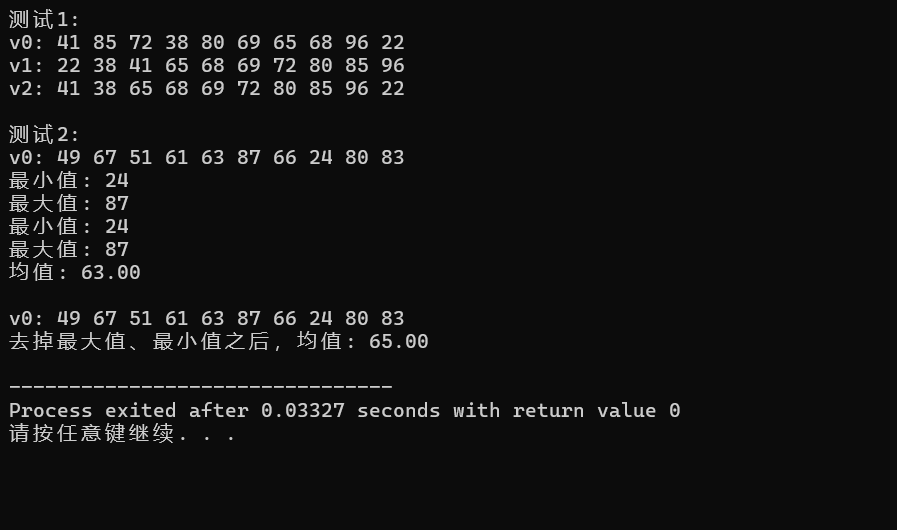
3.实验任务3
#include <iostream> #include <string> #include <algorithm> bool is_palindrome(std::string s); int main() { using namespace std; string s; while(cin >> s) // 多组输入,直到按下Ctrl+Z后结束测试 cout << boolalpha << is_palindrome(s) << endl; } bool is_palindrome(std::string s){ int len = s.length(); for(int i = 0 ; i < len / 2 ; i++){ if(s.at(i) != s.at(len - i - 1)){ return false; } } return true; }
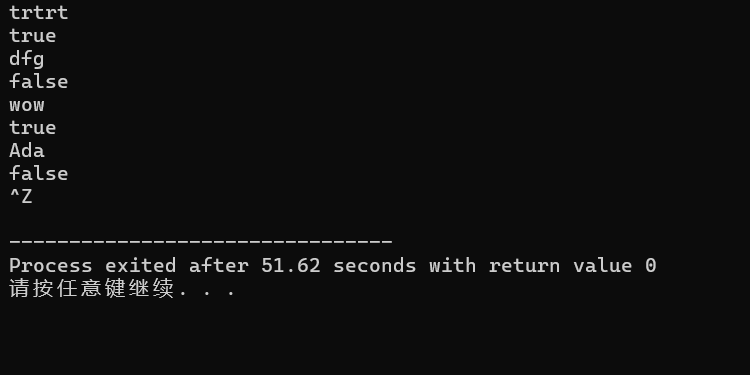
4.实验任务4
#include <iostream> #include <string> #include <algorithm> std::string dec2n(int x, int n = 2); int main() { using namespace std; int x; while(cin >> x) { cout << "十进制: " << x << endl; cout << "二进制: " << dec2n(x) << endl; cout << "八进制: " << dec2n(x, 8) << endl; cout << "十六进制: " << dec2n(x, 16) << endl << endl; } } std::string dec2n(int x , int n){ if (x == 0) return "0"; std::string res; res.reserve(101); int remain = 0; while(x > 0){ remain = x % n; x /= n; if(remain <= 9){ res += (remain + '0'); } else if(remain > 9){ res += ('A' + remain - 10); } } std::reverse(res.begin(), res.end()); return res; }
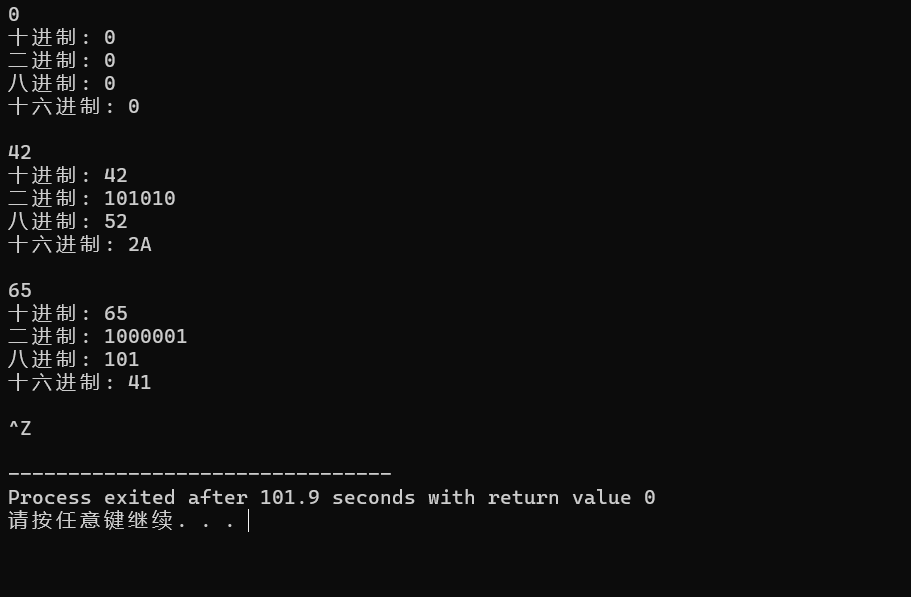
5.实验任务5
#include <iostream> #include <string> #include <algorithm> #include <vector> #include <iomanip> using namespace std; template<typename T> void output(const T &c) { for(auto &i: c) cout << i << " "; cout << endl; } int main(){ vector<char> alpha; cout << " "; char uni = '`'; for(int i = 0 ; i <= 25 ; i++){ uni += 1; char UNI = uni - 32; alpha.push_back(UNI); cout << setw(2) << uni; } cout << endl; for(int i = 1 ; i <= 26 ; i++){ cout << setw(2) << i << " "; rotate(alpha.begin(), alpha.begin()+1, alpha.end()); output(alpha); } return 0; }
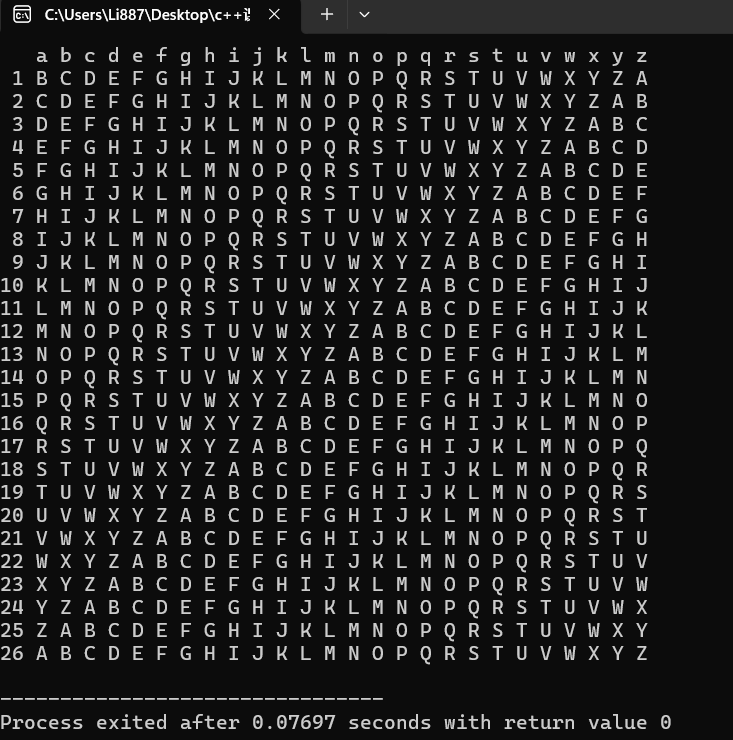
6.实验任务6
#include <iostream> #include <vector> #include <cstdlib> #include <ctime> #include <iomanip> using namespace std; vector<char> sym{'+' , '-' , '*' , '/'}; int gr_sym(){ srand(static_cast<unsigned int>(time(nullptr))); int randomN = rand() % 4; return randomN; } bool judge(int a1 , int a0 , int a2 , int res); int main(){ int true_num = 0; for(int i = 0 ; i < 10 ; i++){ int num1 = rand() % 10 + 1; int num0 = gr_sym(); char symbol= sym[num0]; int num2 = rand() % 10 + 1; if(num0 == 1){ while(num2 > num1){ num2 = rand() % 10 + 1; } } else if(num0 == 3){ while(num1 % num2 != 0){ num2 = rand() % 10 + 1; } } cout << num1 << " " << symbol << " " << num2 << " = "; int kook; cin >> kook; if(judge(num1 , num0 , num2 , kook) == true){ true_num++; } } double rate = (true_num * 1.0 )/ 10; cout << "正确率:"<< fixed << setprecision(2) << (rate * 100)<< "%" << endl; return 0; } bool judge(int a1 , int a0 , int a2 , int res){ int ans; switch(a0){ case 0: ans = a1 + a2; break; case 1: ans = a1 - a2; break; case 2: ans = a1 * a2; break; case 3: ans = a1 / a2; break; } if(res == ans){ return true; } else if(res != ans){ return false; } }
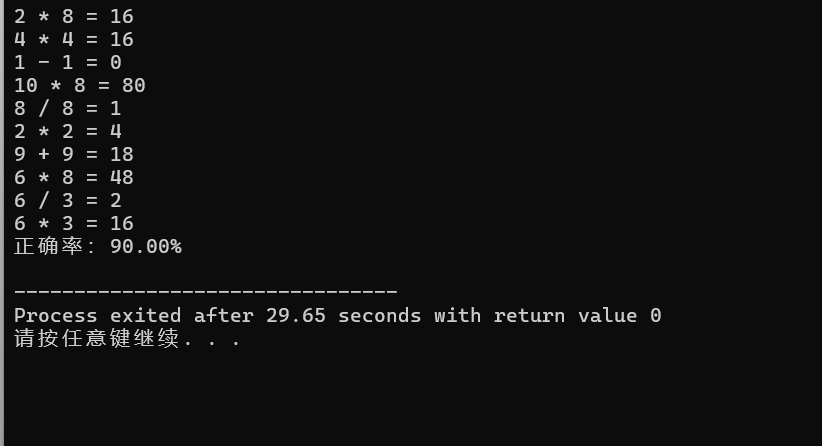
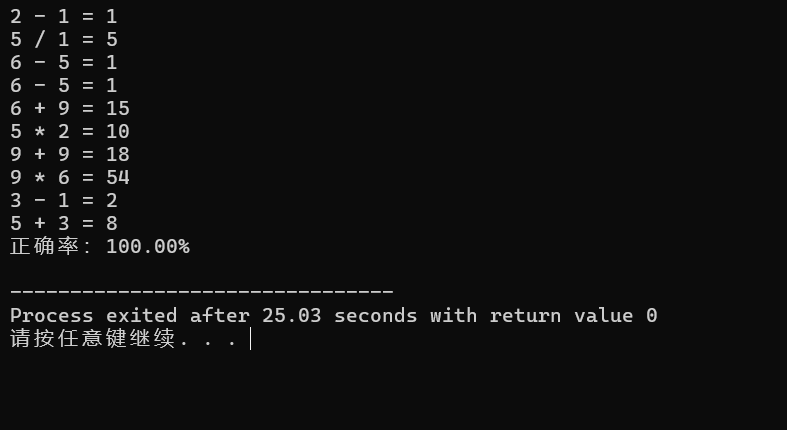



 浙公网安备 33010602011771号
浙公网安备 33010602011771号